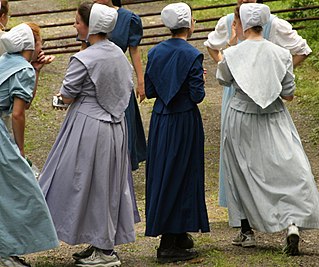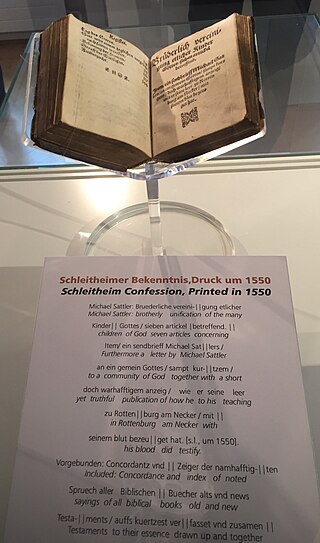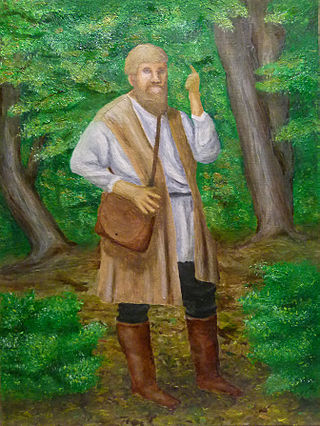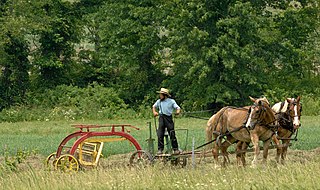Anabaptism is a Christian movement which traces its origins to the Radical Reformation.

Mennonites are a group of Anabaptist Christian church communities tracing their roots to the Radical Reformation. The name is derived from one of the early prominent leaders of the Anabaptist movement, Menno Simons (1496–1561). Through his writings about Reformed Christianity during the Radical Reformation, Simons articulated and formalized the teachings of earlier Swiss founders, with the early teachings of the Mennonites founded on the belief in both the mission and ministry of Jesus, which the original Anabaptist followers held with great conviction, despite persecution by various Roman Catholic and Mainline Protestant states. Formal Mennonite beliefs were codified in the Dordrecht Confession of Faith in 1632, which affirmed "the baptism of believers only, the washing of the feet as a symbol of servanthood, church discipline, the shunning of the excommunicated, the non-swearing of oaths, marriage within the same church", strict pacifistic physical nonresistance, anti-Catholicism and in general, more emphasis on "true Christianity" involving "being Christian and obeying Christ" as they interpret it from the Holy Bible.

The Schleitheim Confession was the most representative statement of Anabaptist principles, by a group of Swiss Anabaptists in 1527 in Schleitheim, Switzerland. The real title is Brüderliche vereynigung etzlicher Kinder Gottes siben Artickel betreffend ....

Plain people are Christian groups characterized by separation from the world and by simple living, including plain dressing in modest clothing. Many Plain people have an Anabaptist background. These denominations are largely of German, Swiss German and Dutch ancestry, though people of diverse backgrounds have been incorporated into them. Conservative Friends are traditional Quakers who are also considered plain people; they come from a variety of different ethnic backgrounds.

The Nebraska Amish, also called Old Schoolers, are a relatively small affiliation of the Amish. They are the most conservative subgroup of Amish, indicated not only by their use of technology but also by their particular style of dress. They emerged in 1881 as a conservative split from the Byler Amish, who themselves emerged as the first conservative splinter group from the Amish mainstream in 1849.

The Old Order River Brethren are a River Brethren denomination of Anabaptist Christianity with roots in the Radical Pietist movement. As their name indicates, they are Old Order Anabaptists.

The Mennonite Church USA is an Anabaptist Christian denomination in the United States. Although the organization is a recent 2002 merger of the Mennonite Church and the General Conference Mennonite Church, the body has roots in the Radical Reformation of the 16th century.
The Fellowship of Evangelical Bible Churches (FEBC) is a small evangelical Christian denomination with an Anabaptist Mennonite heritage. Most of the denomination's approximately 5000 members are in congregations located in the U.S. and Canada.

Anabaptist theology, also known as Anabaptist doctrine, is a theological tradition reflecting the doctrine of the Anabaptist Churches. The major branches of Anabaptist Christianity agree on core doctrines but have nuances in practice. While the adherence to doctrine is important in Anabaptist Christianity, living righteously is stressed to a greater degree.

The Mennonite Central Committee (MCC) is a relief service, and peace agency representing fifteen Mennonite, Brethren in Christ and Amish bodies in North America. The U.S. headquarters are located in Akron, Pennsylvania; the Canadian headquarters is located in Winnipeg, Manitoba.
Peace churches are Christian churches, groups or communities advocating Christian pacifism or Biblical nonresistance. The term historic peace churches refers specifically only to three church groups among pacifist churches:
Donald B. Kraybill is an American author, lecturer, and educator on Anabaptist faiths and culture. Kraybill is widely recognized for his studies on Anabaptist groups and in particular the Amish. He has researched and written extensively on Anabaptist culture. He is Distinguished Professor Emeritus at Elizabethtown College and Senior Fellow Emeritus at Elizabethtown's Young Center for Anabaptist and Pietist Studies.

Michael Sattler was a monk who left the Roman Catholic Church during the Protestant Reformation to become one of the early leaders of the Anabaptist movement. He was particularly influential for his role in developing the Schleitheim Confession.
John A. Hostetler was an American author, educator, and scholar of Amish and Hutterite societies. Some of his works are still in print.
Guy F. Hershberger was an American Mennonite theologian, educator, historian, and prolific author particularly in the field of Mennonite ethics.
The Bible Mennonite Fellowship (BMF) is a Mennonite confederation of churches founded in 1958. There are three churches in the conference; one in Brownsville, Oregon, one in Sheridan, Oregon, and one in Woodside, Montana. The large Fairview Mennonite Church in Albany, Oregon is unofficially affiliated with the group. A small congregation in Winston, Oregon is also affiliated with, but not formally a member of the group.
Belize Evangelical Mennonite Church is a church denomination of the Fellowship of Evangelical Bible Churches in Belize.

The Renno Amish, also called Beachy Amish or "black toppers" are a subgroup of Amish that was formed in 1863 in Mifflin County, Pennsylvania. They are the moderately conservative Old Order Amish group in Kishacoquillas Valley, locally called Big Valley, but still relatively conservative compared with the Amish of other regions.

The Byler Amish, also called Alt Gemee, are a small conservative subgroup of the Amish. They are known for the yellow color of their buggies, which earned them the nickname "yellow-toppers" and for wearing only one suspender. They are the oldest Old Order Amish affiliation that separated for doctrinal and not for geographical reasons.
Samuel Frederick Coffman was a Canadian minister, writer and pacifist.











